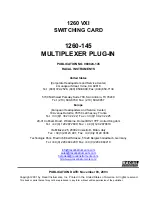
capacitance)
Notes:
•
If
the
tested
capacitor
is
shorted
or
its
capacity
is
over
the
specified
range
“OL”
symbol
will
be
displayed
on
the
screen.
•
When
measuring
large
capacitors,
it
may
take
a
few
seconds
to
obtain
steady
readings.
•
Before
measuring
capacitors
(especially
for
high
voltage
capacitors),
please
fully
discharge
them.
6.
Frequency/Duty
ratio
measurement
(see
figure
8)
At
the
frequency
position,
press
the
Hz/%
to
select
frequency/duty
ratio
measurement
mode.
Notes:
•
Do
not
input
voltage
over
DC
60V
or
AC30V.
7.
Temperature
measurement
(see
figure
9)
Turn
on
the
device,
after
“OL”
symbol
appears,
insert
K
‐
thermocouple
into
the
device.
Note:
Only
K
‐
type
thermocouple
is
applicable.
The
measured
temperature
should
be
less
than
230
˚
C/
446
˚
F
(
˚
F=
˚
C*1.8+32)
8.
AC/DC
current
measurement
(see
figure
10)
Connect
test
leads
with
the
tested
circuit
in
series.
Readings
under
this
AC
measurement
is
true
RMS.
Notes:
•
Before
measuring,
switch
off
the
power
supply
of
the
circuit.
•
If
the
range
of
the
measured
current
is
unknown,
select
the
maximum
range
and
then
accordingly
reduce.
•
There
are
fuses
inside
10A
jack
and
mA/
μ
A
jack.
Do
not
connect
the
test
leads
with
any
circuits
in
parallel.
•
If
the
tested
current
is
over
5A,
each
measurement
time
should
be
less
than
10
seconds
and
the
next
test
should
be
after
15
minutes.
•
When
measuring
AC
current,
press
Hz/%
button
to
display
AC
frequency
or
duty
ratio.
•
60A
AC
and
DC
current
clamp
measurement
(see
figure
11)
Connect
as
shown
with
the
attached
current
clamp.
9.
NCV
measurement
(see
figure
12)
1
)
Switch
the
dial
to
NCV
position





























